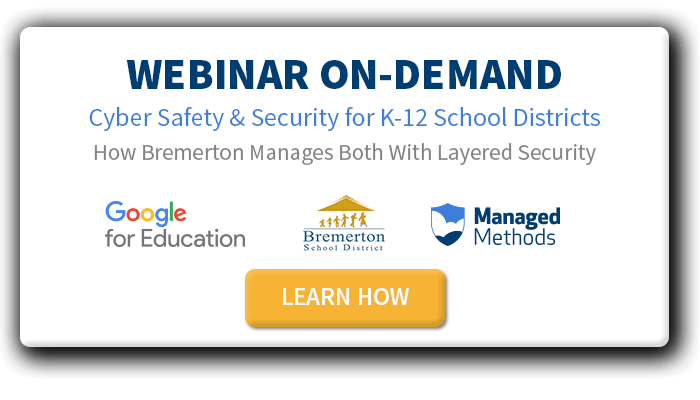Cloud security for schools is as critical as pencils and Chromebooks
Remember the excitement of heading back to school? Spending hours organizing your pencil box and binder until you got it just right? Fresh notebooks ready to be filled with notes and doodles?
For today’s student, the same excitement is there, but the tools have changed. Instead of binders, there are smartphones and laptops. Instead of notebooks, there are cloud apps, like Google G Suite and Microsoft 365.
Students have the world at their fingertips. Most of the time people think and talk about the changes this technology has brought to collaboration and communication in schools. But there is another side—the security needed for cloud apps.
Cybersecurity: Schools Facing New Threats
Cloud apps bring a lot of benefits to the classroom; however, they also bring a different type of threat. Cloud security for schools is especially important considering the sensitive student information that is shared on a daily basis in schools.
K-12 cybersecurity is a growing problem. Each passing year introduces new data breaches that show just how unprepared school districts are for a future in the cloud. Email, file attachments, collaborating in cloud apps like Google Suite and Microsoft 365 are all day-to-day tools common throughout every level of our education system. However helpful this technology is for communication and collaboration, there are security risks that needs to be addressed.
[WATCH NOW] HOW BREMERTON S.D. KEEPS STUDENTS SAFE AND SECURES DATA IN G SUITE FOR EDUCATION. CLICK HERE TO WATCH >>
Here are just a few potential cloud security problems school districts face:
- Phishing and malware schemes through email leading to data loss or corruption
- Sharing of sensitive student or employee personal information that goes against school policies
- Compliance with federal and state regulations like FERPA, COPPA, HIPAA, etc.
When a school district makes the transition to cloud computing, IT often mistakenly believes that their firewall—or the cloud app itself—is sufficient to protect student data. Unfortunately, this is simply not the case. Once the information is migrated to the cloud, it has left the district network, the perimeter of which is exactly where the security benefits of a firewall stops. Believing that all the security is handled by the app provider is also a misunderstanding. App vendors are responsible for the security of their apps infrastructure, and for the communication between the app and the vendor’s servers. But you are responsible for securing district data stored, accessed, created, and shared in your cloud applications.
Fortunately, cloud security for schools that use G Suite, Office 365, and/or others doesn’t have to be complicated (or expensive). The first step is to get a “bird’s eye view” of what is going on with your data in these applications. You can take advantage a 30-day free trial to audit your environment. This will allow you to see if there are data loss, phishing and malware, account takeover, and other risks hiding in your school cloud applications.
Student Cyber Safety & Data Security Converges
As the internet and virtual resources became more popular and available, schools implemented content filters for their networks. Now, a lot of schools are 1:1, meaning students are given computers, iPads, Chromebooks, etc. for the school year. Some schools have even moved to electronic books. (See ya heavy backpacks!) Students are communicating and working together more and more online and off campus.
This leads to blurred lines for schools when it comes to student safety and security. Who is responsible if a student has inappropriate content stored in an app used by the school? Even if it was done at home, it was still done on school property. How does a school keep all the technology and equipment safe from malware and phishing when it’s not on the school network?
Administrators and parents are looking to district IT teams to help answer these questions. The move to 1:1 programs and cloud computing have also lead to the possibility of detecting behavioral and/or domestic issues that require school resources to get involved. While the ability to help shed some light on these incidents is rewarding to many IT admins in education, they are also finding themselves stumbling into uncharted territory. No matter how much they may want to help, IT pros are not child psychologists. With all the tools available to them to be able to detect an incident, or provide additional information when one occurs, they are caught in the middle of some very sensitive scenarios. Many are struggling with more than just the time requirements this new territory demands. They’re struggling to effectively understand when a red flag is a real warning or a false alert.
Cyber Safety & Security Needs A Solution
ManagedMethods’ goal is to make cloud security simple and affordable, so educators can focus on what’s important to them: the students.
It’s important for schools to be proactive about cloud security. Bremerton School District in Washington, a large, technology-forward school district, implemented our customizable cloud security system to quickly gain visibility and flexibility in cloud security for their students and staff. Small districts benefit from our easy and affordable solution as well. Troy ISD, a Texas district with just 1,500 students, likes how ManagedMethods helps the district meet federal and state compliance requirements, and provides real-time visibility of objectionable content and other threats in G Suite.
Learn how the IT team at Bremerton School District manages to balance the requirements of a cloud-enabled school district, working to keep data secure and student safe—without losing their sanity!

